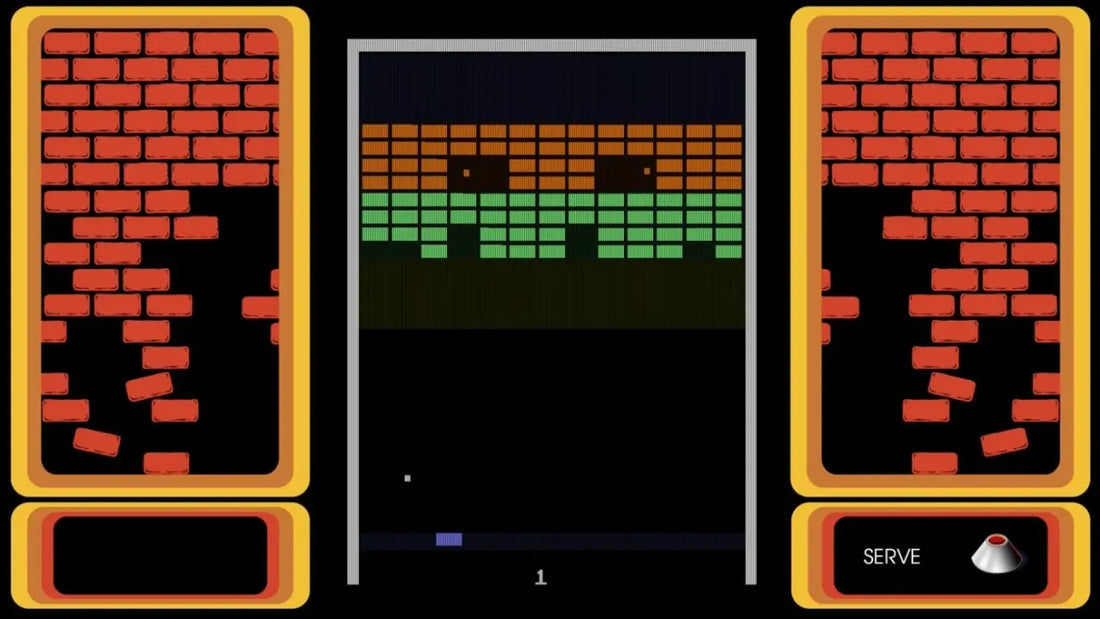
Atari historian Martin Goldberg has shared transcripts of discussions with Gary Waters, Steve Bristow and Don Lange that provide new insights into Breakout’s creation.
Breakout was created to capitalize on Atari’s previous Pong success and retained many of that game’s paddle and ball mechanics. It remains a significant title in Atari’s legacy because many of the individuals that worked on the game went on to have groundbreaking careers in gaming, entertainment, and technology. Steve Wozniak and Steve Jobs were two of the founders of Apple, and Gary Waters joined Grass Valley where he designed more games and worked on iconic Chuck E Cheese animatronics. Perhaps realizing the games historical significance, Gary had saved Wozniak’s original Breakout code for years:
“It is a shame that we don’t have the original schematics, drawn by Woz, on C size manila paper. I had those pages in my design records up until I was laid-off in 1984.”
Breakout’s prototype was created by Steve Wozniak but was later redesigned by Gary who was challenged with rebuilding the game for mass production. Gary told Martin that when he first received the game:
“The prototype board was only a single player, it had no sound, and it had no score keeping, however, these things could have (and were) easily overcome in the production version.”

While the concept for Breakout had come directly from Atari founder Nolan Bushnell, Wozniak had been tasked with dramatically reducing the number of chips the game required — more than 200 per game was common — and he was able to reduce the number to just 45 over a four day development marathon. Wozniak’s code was innovative because it dramatically cut costs by using far fewer logic chips than other games.
Marty: Steve Bristow and Al made it seem like Woz cheated by using RAM on his prototype for the bricks, and that it had to be stripped out because it was cost prohibitive. That’s obviously not the case it seems, because your production version uses RAM as well – the same 256×1 bit RAM in fact. Can you elaborate on this? Did they initially want it stripped and then left it because they found a cheap source? Or were you told to leave it in from the beginning?
Gary: In that time frame RAM was moderately expensive but we’re only talking about one chip (or certainly only a few) per board. The use of the RAM was never an issue in my recollection.
It has been reported that the original code was too difficult for other designers to understand and therefore had to be remade. In his discussion with Marty, Gary explained that the code was actually quite clear, but the team at Atari felt it could not be used for the final version because in order to use fewer chips, Wozniak used methods that wouldn’t translate well into mass production.

Gary: The overwhelming problem with the design was the counter chains (so called
“slipping counters”) used in Vertical Sync., Horizontal Sync., and the associated H and V sync circuits of the ball and the paddle motion. The problem with them was in an effort to use less chips, unreliable and unrepeatable glitch logic was used to short circuit the need for more chips to implement synchronous clocking logic.”
Steve Bristow, the creator of Tank who also worked on Breakout, gave Gary Waters the lion’s share of credit for that incremental work:
“Gary was very good … and I do credit him with making Breakout real.”
The iterative approach to game development that forms the basis of the Breakout story extends 50 years forward to Breakout: Recharged. The product of a collaboration between game designer Adam Nickerson, Atari producer Jason Polansky, and game studio SneakyBox, Breakout: Recharged adapts the core game concepts to modern gaming platforms, with a 16:9 field of play, HD graphics, and support for modern controllers.
“Revisiting iconic titles like Breakout, which has such a formative role in the industry is a great challenge, and one that our team really has enjoyed,” said Jason Polansky, who produces the Recharged series at Atari. “The goal of the Recharged series is to reinterpret classic Atari games for modern hardware and the expectations of modern players, without deviating too far from the core gameplay that made them such classics.
You can learn more about Breakout: Recharged at recharged.atari.com








